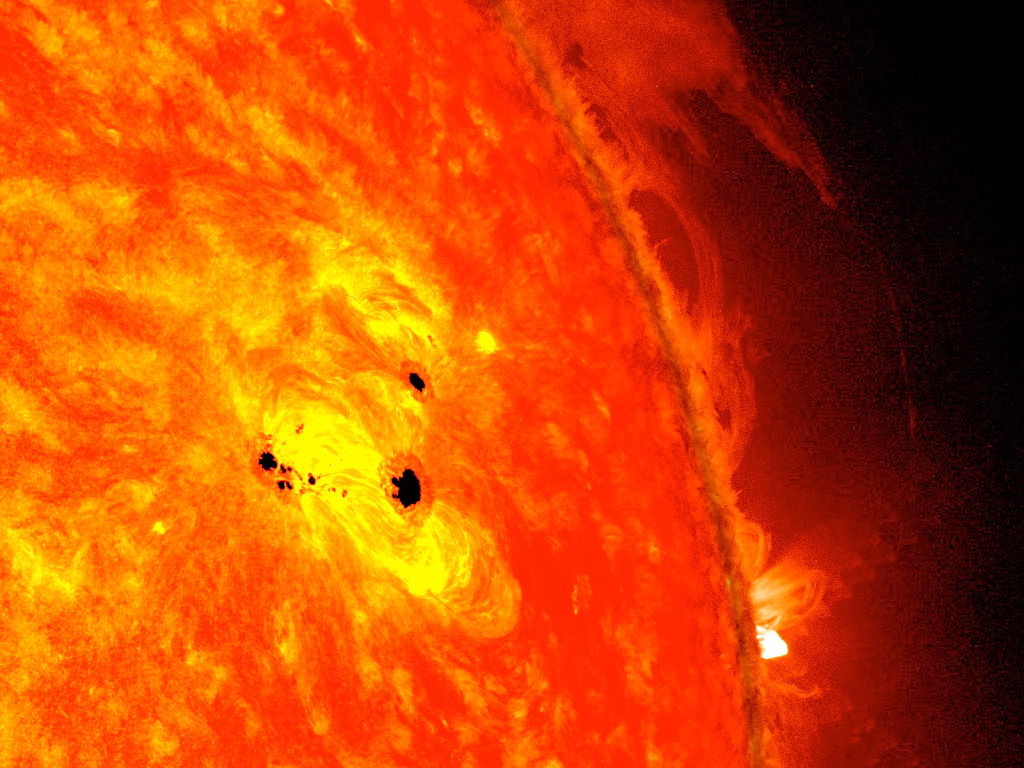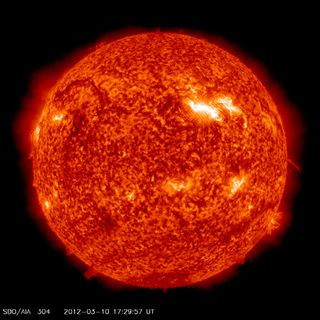NASA Sees Monster Sunspot Growing Fast, Solar Storms Possible

A colossal sunspot on the surface of the sun is large enough to swallow six Earths whole, and could trigger solar flares this week, NASA scientists say.
The giant sunspot was captured on camera by NASA's Solar Dynamics Observatory as it swelled to enormous proportions over the 48 hours spanning Tuesday and Wednesday (Feb. 19 and 20). SDO is one of several spacecraft that constantly monitor the sun's space weather environment.
"It has grown to over six Earth diameters across, but its full extent is hard to judge since the spot lies on a sphere, not a flat disk," wrote NASA spokeswoman Karen Fox, of the agency's Goddard Space Flight Center in Greenbelt, Md., in an image description.
The sunspot region is actually a collection of dark blemishes on the surface of the sun that evolved rapidly over the last two days. Sunspots form from shifting magnetic fields at the sun's surface, and are actually cooler than their surrounding solar material.
According to Fox, some of the intense magnetic fields in the sunspot region are pointing in opposite directions, making it ripe for solar activity.
"This is a fairly unstable configuration that scientists know can lead to eruptions of radiation on the sun called solar flares," Fox explained.

NASA's Solar Dynamics Observatory launched in 2010 and is just one of a fleet of spacecraft keeping close watch on the sun for signs of solar flares, eruptions and other space weather events.
Get the Space.com Newsletter
Breaking space news, the latest updates on rocket launches, skywatching events and more!
You can follow SPACE.com Managing Editor Tariq Malik on Twitter @tariqjmalik. Follow SPACE.com on Twitter @Spacedotcom. We're also on Facebook & Google+.
Join our Space Forums to keep talking space on the latest missions, night sky and more! And if you have a news tip, correction or comment, let us know at: community@space.com.

Tariq is the Editor-in-Chief of Space.com and joined the team in 2001, first as an intern and staff writer, and later as an editor. He covers human spaceflight, exploration and space science, as well as skywatching and entertainment. He became Space.com's Managing Editor in 2009 and Editor-in-Chief in 2019. Before joining Space.com, Tariq was a staff reporter for The Los Angeles Times covering education and city beats in La Habra, Fullerton and Huntington Beach. In October 2022, Tariq received the Harry Kolcum Award for excellence in space reporting from the National Space Club Florida Committee. He is also an Eagle Scout (yes, he has the Space Exploration merit badge) and went to Space Camp four times as a kid and a fifth time as an adult. He has journalism degrees from the University of Southern California and New York University. You can find Tariq at Space.com and as the co-host to the This Week In Space podcast with space historian Rod Pyle on the TWiT network. To see his latest project, you can follow Tariq on Twitter @tariqjmalik.